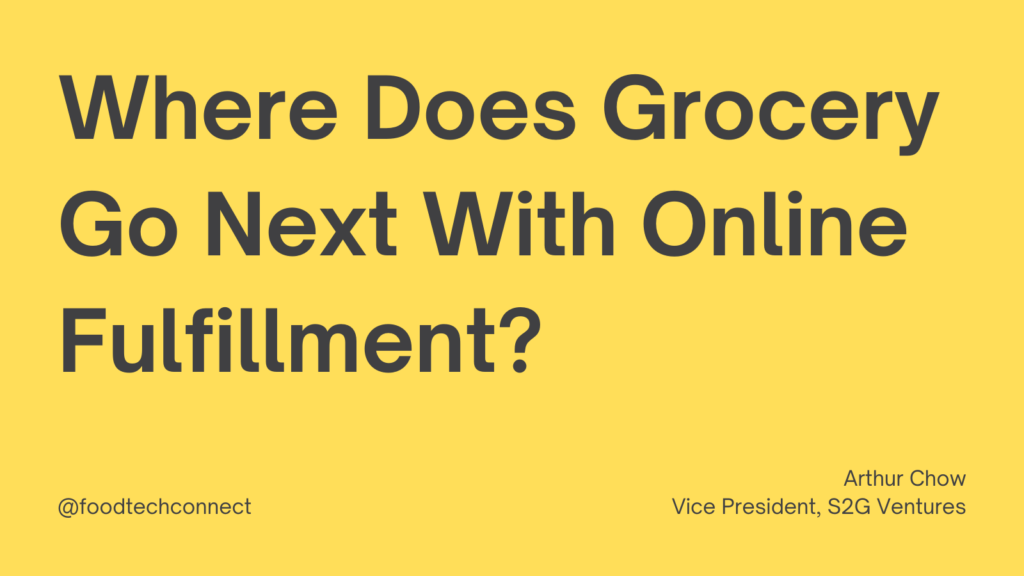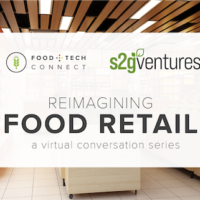
This is a guest post by Arthur Chow, Vice President of S2G Ventures
In trying to envision the future of grocery, we at S2G Ventures go back to how it all began. In 1916, Clarence Saunders opened the first Piggly Wiggly store and changed how people shop for food. The chain’s revolutionary self-service operations, which allowed customers to browse four times the product variety of the average store, unlocked a simple truth: Americans like to pick their own groceries.
While customers were delighted they did not have to wait behind a cramped counter for a store clerk to pick goods off a list, this was also a boon for retailer efficiency. With customers picking their own items, store traffic increased along with basket size from impulse purchases. (Who hasn’t grabbed candy or gum on the way out before?)
For the last century, this is how America has preferred to shop for its groceries, even as the internet became an omnipresent force in other areas of our lives. Prior to 2020, it has been well-documented e-commerce penetration of grocery spend struggled to reach more than 3% of overall spend compared to several other categories that are 30% or greater.
Then overnight, the COVID-19 pandemic forced all retailers to pivot as previously covered in our Future of Food: Through the Lens of Retail report. Whether curbside pickup or delivery, offering some form of online ordering and fullfilment became table stakes for grocery retailers, with a few notable holdouts such as Trader Joe’s. This stressed the retailers who were not ready to meet the surge in online demand, and showed the cracks in the resiliency of an omni-channel model.
Online fulfillment, which most traditional retailers had only begun testing 10 months ago, became a problem everyone needed to solve today.
Without the physical and technical infrastructure (which would have required investment years in advance) ready to manage online orders, many retailers turned to Instacart for a capital expenditure-light and scalable solution. But with an industry already operating at 3-5% margin, the 10% commission fee can become a losing proposition. There are no VCs at the beckoning to fund brick and mortar retailers’ growing losses as they effectively pay for the right to each additional order online. Thus, as Bain and others have concluded, supermarkets must invest in fulfillment automation to be profitable. Instacart’s recent layoffs and shift to its “Partner Pick” model, where retailers manage their own physical fulfillment of orders through Instacart’s online portal, further shows the need for grocers to own that part of the supply chain in order to build a profitable and resilient fulfillment model.
But within that hefty investment decision, retailers are still faced with another choice: should they centralize automated fulfillment in a large facility dedicated to high speed and high volume, or go with a decentralized micro-fulfillment (“MFC”) model and still pick from individual stores? Asked differently, do you want all your groceries sitting in one big automated warehouse, or spread out among many little warehouses (aka your stores) closer to customers?
Enter the origins of Amazon and the supply chain principle it used to disrupt the entire book industry.
One could easily point to Webvan as the poster child of the perils of big-time automation, but that would miss a deeper lesson about logistics that catapulted Amazon. Before having the foresight to invest in cloud computing services, Jeff Bezos understood a basic supply chain principle that led to wild success: niche, specialized and slow-moving products are better suited to be sold online.
Amazon is now referred to as the “Everything Store,” but does anyone remember when it was just a bookstore? And what are most books? Niche, specialized items that consumers buy infrequently (relative to food).
Why does this principle hold true? Because to minimize a good’s total cost of logistics, one must factor in 1) the cost to hold a product (inventory cost) and 2) the cost to ship a product (transportation or setup costs). Seems simple? To add a bit more complexity, how fast a good sells (its demand) should determine how much of the good to hold and where to hold it. This is a basic principle to forming your supply chain network strategy.
Here’s a hypothetical illustration. Imagine you are searching for a copy of Fluid Concepts And Creative Analogies: Computer Models Of The Fundamental Mechanisms Of Thought. You can shop online with Amazon or in-person at Borders at one of its 500 stores (because this is still ~2010). The publishing industry tracks that only 100 copies are sold on average each year. However, Borders doesn’t know exactly which stores the customer will show up at, so they still stock 500 copies (one at each store) to ensure there are no missed sales or “out-of-stocks.”
In contrast, Amazon’s one storefront is virtual. They only need to stock 100 copies in a central warehouse to comfortably meet the expected demand. It will cost Amazon more to ship a book directly to its customer, since the Border’s customer helped solve the last mile by shopping at the store. But Amazon saves money on all that real estate cost and, perhaps more importantly, frees up more cash to buy other book titles. In fact, with its online storefront, Amazon can hold millions of titles that far exceed the physical capacity of any bookstore. Finally, the customer also enjoys the convenience of having the book delivered and usually doesn’t mind waiting a few days (again this is 2010). This is how you build an empire in books, CDs, DVDs, consumer electronics, toys, games… and subsequently start the “retail apocalypse.”
Thus, the supply chain concept enabled by the internet and pioneered by a man in a Seattle garage becomes very clear – if you sell a niche, slow-moving good, you should centralize your inventory in a big warehouse, sell online, and ship directly
But a banana is not a book – it is neither niche nor slow-moving, and it spoils a lot quicker. At 85% US household penetration, most people buy bananas and they buy them frequently. As a grocery retailer, you know customers will show up each day to buy food and basic staples with some predictability, 2020 notwithstanding. Groceries are the antithesis to books when it comes to demand, and a grocer’s supply chain should look vastly different to a book seller’s. Delivering bananas to individual homes each day across the US from one central warehouse in Seattle becomes an increasingly expensive proposition as you grow. Logistically with delivery, your customer base needs to have the stable route density of an urban environment to match how efficient a semi-truck is dropping off a trailer load behind a store. Factor in spoilage or damage, and it’s no wonder most of the grocery world still largely exists as brick and mortar.
Thus, this author believes the fulfillment of mass perishable grocery will remain decentralized, whether the customer is shopping online for delivery or coming to the store. For core perishable items reaching a mass audience, having a hyper local focus will be a winning strategy. Micro-fulfillment will be key in allowing retailers to adapt profitably to a changing consumer market. Brick and mortar can still be a competitive advantage in fresh, even with the increasing consumer shift to ordering digital.
Amazon seems to believe as much. It bought Whole Foods in 2017, a decade after launching Amazon Fresh in 2007 and struggling to gain footing in the grocery industry. Doubling down on brick and mortar, the tech giant has opened up new physical supermarkets in LA and Chicago in 2021.
At the end of the day, 90% of what you buy is likely to have been carried on a commercial truck at some point. For ubiquitous fast-moving goods like groceries, it will always be most efficient to have products sourced from nearby the consumer. Fulfillment of grocery online, whether delivery or pickup in-store, will need to stay local to be profitable.
Our conversation was a part of our Reimagining Food Retail Conversation Series that was inspired by S2G’s recently released Future of Food: Through the Lens of Retail Report as a framework. The series will examine how innovations in content, commerce and community might transform the shape of the future of food retail.
Join us for future Redesigning Retail conversations here.
 Arthur Chow is a Vice President at S2G Ventures. He is focused on the evaluation and execution of potential investments as well as serving the needs of portfolio companies.
Arthur Chow is a Vice President at S2G Ventures. He is focused on the evaluation and execution of potential investments as well as serving the needs of portfolio companies.
Arthur has nearly a decade of investing and operating experience in the food industry. He began his career as an investment banking analyst at UBS. He then joined Frontenac, a Chicago-based middle-market private equity firm, as an Associate focused on food and consumer buyouts. Seeking to explore an operating role within food, Arthur oversaw the commercial performance of a $2 billion P&L at the Kraft Heinz Company as an Associate Director in the Foodservice business unit. Searching for more early-stage mission-oriented companies, Arthur joined S2G as a Senior Associate. While pursuing his MBA before re-joining S2G, he worked for several food startups with exceptional founders in financial, marketing and operating roles. These include Tovala, a direct-to-consumer smart oven and meal kit service platform; Once Upon a Farm, a cold-pressed organic baby food brand; and Dom’s Market and Kitchen, a next generation grocery retail concept.





